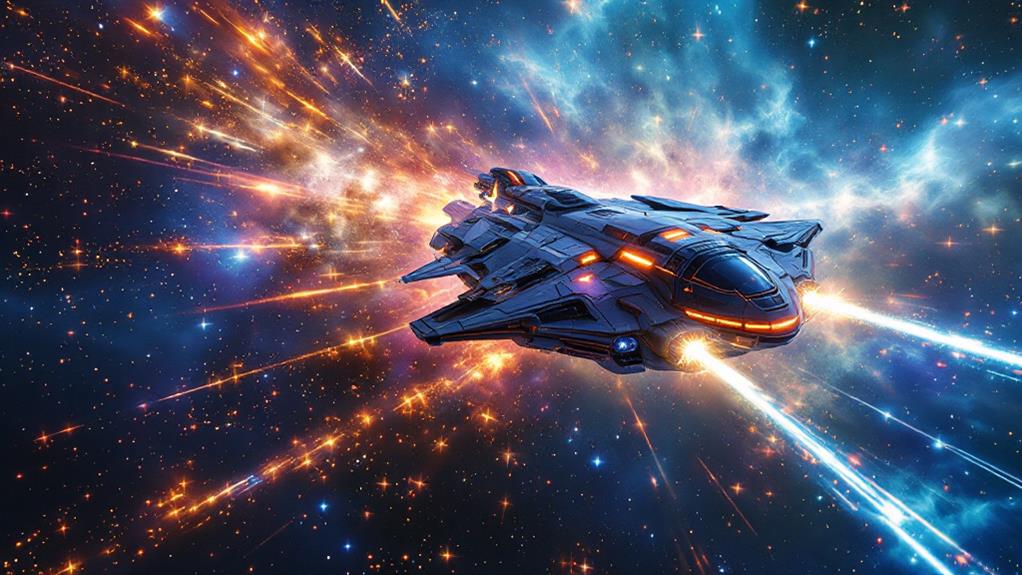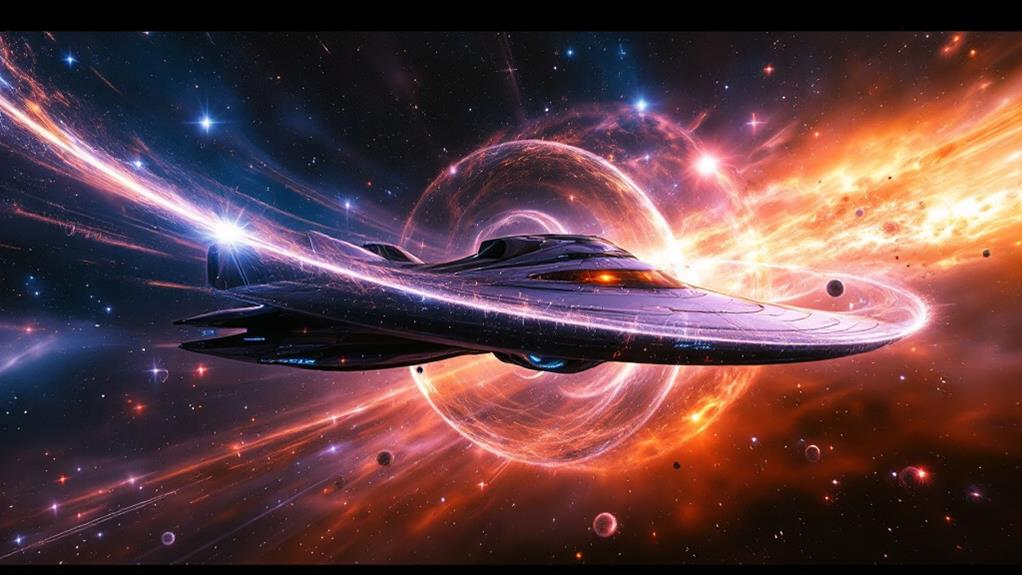Is Warp Speed Space Travel Possible? Exploring the Science of Faster-Than-Light Travel

Warp speed space travel remains firmly in the domain of science fiction for now. While Einstein's theories allow for the possibility of wormholes and spacetime manipulation, enormous technological hurdles stand in the way. The light-speed barrier poses a fundamental challenge, requiring infinite energy to overcome. Concepts like the Alcubierre drive offer tantalizing glimpses of potential solutions, but they rely on exotic matter and energy sources beyond our current capabilities. Quantum entanglement, while fascinating, can't transmit information faster than light. Despite these obstacles, scientists continue to investigate theoretical possibilities that might one day uncover the stars.
Understanding the Light-Speed Barrier
To grasp the concept of warp speed travel, we must first tackle the light-speed barrier. You've probably heard that nothing can travel faster than light, but why is this the case? It all comes down to Einstein's theory of special relativity.
As you approach the speed of light, several strange phenomena occur. Time slows down for you relative to stationary observers, a phenomenon known as time dilation. You'd also experience an increase in mass, making it increasingly difficult to accelerate further. These effects become more pronounced the closer you get to light speed.
General relativity constraints further complicate matters. As your speed increases, so does the energy required to accelerate. To reach light speed, you'd need an infinite amount of energy—an impossible feat.
But what if you could bypass these limitations? That's where the concept of warp speed comes in. Instead of trying to break through the light-speed barrier, warp drive theories propose bending spacetime itself. By manipulating the fabric of space, you might be able to achieve faster-than-light travel without actually moving faster than light within your local reference frame.
Wormholes: Shortcuts Through Spacetime
While warp drives propose bending spacetime, wormholes offer another intriguing possibility for faster-than-light travel. Imagine a shortcut through the fabric of spacetime, connecting two distant points in the universe. That's the essence of a wormhole.
You can picture a wormhole as a tunnel connecting two separate regions of spacetime. In theory, you could enter one end and exit the other almost instantaneously, regardless of the distance between them. This would effectively allow you to travel faster than light without actually breaking the cosmic speed limit.
Wormholes arise from Einstein's equations of general relativity, which describe how matter and energy curve spacetime. The gravitational effects near a wormhole's mouth would create intense spacetime distortions, potentially allowing for time travel as well as spatial shortcuts.
However, wormholes face significant challenges. They're inherently unstable and would collapse quickly without exotic matter to hold them open. You'd also need to contend with intense tidal forces and radiation. While theoretically possible, traversable wormholes remain firmly in the domain of science fiction for now.
The Alcubierre Drive Concept

The Alcubierre drive concept stands out as one of the most promising theoretical approaches to faster-than-light travel. Named after physicist Miguel Alcubierre, this propulsion system proposes warping the fabric of spacetime to achieve superluminal speeds. Unlike conventional propulsion methods, the Alcubierre drive doesn't move the spacecraft itself but instead creates a "warp bubble" around it.
You'll find that this concept relies on gravitational distortions to contract space in front of the vessel and expand it behind. By manipulating spacetime in this way, you could theoretically journey faster than light without violating Einstein's special relativity. However, there's a catch: the Alcubierre drive requires exotic matter with negative energy density to function.
While the concept is mathematically sound, the exotic matter requirements pose significant challenges. You'd need an enormous amount of this theoretical substance, which may not even exist in our universe. Additionally, recent studies suggest that such a drive could potentially destroy your destination upon arrival. Despite these obstacles, the Alcubierre drive concept continues to inspire scientists and engineers to investigate new possibilities in space travel.
Quantum Entanglement and FTL Communication
Curiosity about faster-than-light (FTL) communication often leads to discussions of quantum entanglement. This fascinating quantum phenomena involves particles that remain connected regardless of distance, seemingly communicating instantaneously. While this might sound like a perfect solution for FTL communication, it's not that simple.
You can't use entanglement to transmit information faster than light. When you measure one entangled particle, you instantly know the state of its partner, but you can't control which state it'll be in. This randomness prevents FTL communication.
However, entanglement could still play a role in future space travel technologies. It might be used to enhance quantum computers, which could help with complex calculations needed for spacetime manipulation or routing.
Some theorists propose that entanglement might be linked to wormholes, suggesting a connection between quantum mechanics and general relativity. While this doesn't directly enable FTL travel, it could lead to breakthroughs in our understanding of space and time.
For now, quantum entanglement remains a mesmerizing area of research, but it won't get your messages home from Alpha Centauri any faster than light.
Challenges and Future Research

Despite the allure of warp speed travel, significant challenges stand in our way. The primary hurdle is the enormous amount of energy required to bend spacetime and create a warp bubble. Current theories suggest we'd need exotic energy sources with negative mass or energy, which we haven't found yet. Even if we could create such energy, containing and controlling it poses immense technical difficulties.
You'll find that propellant optimization is another essential area of research. Traditional rocket fuel won't cut it for warp drives, so scientists are exploring alternatives like antimatter or fusion-based propulsion systems. These could potentially provide the massive energy output needed, but they come with their own set of challenges regarding production, storage, and safety.
Future research will need to focus on refining our understanding of spacetime manipulation, developing new materials capable of withstanding extreme conditions, and advancing our knowledge of quantum physics. You can expect breakthroughs in these areas to pave the way for practical warp drive technology, but it's likely to take decades, if not centuries, before we see any real-world applications.



